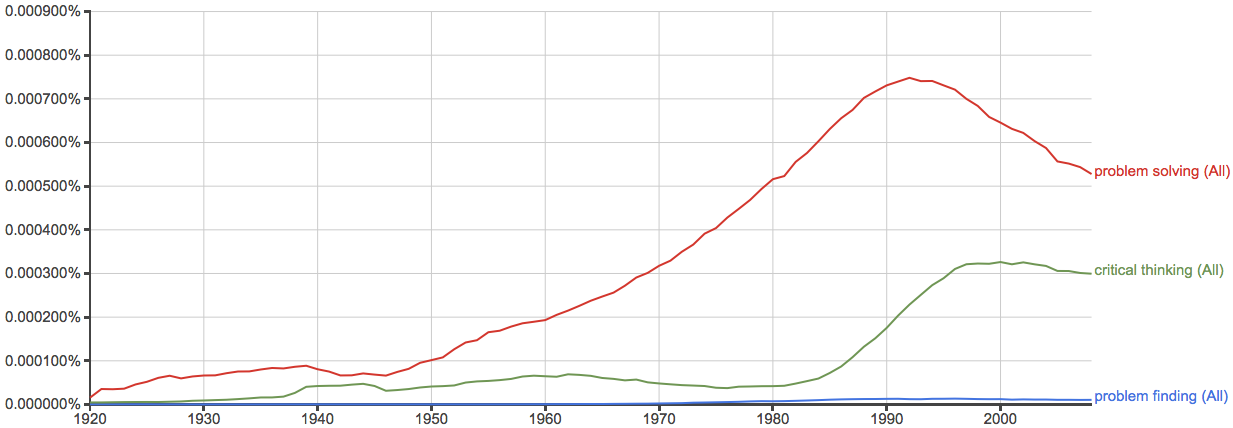The phrase problem finding caught my eye as I was recently reviewing the Isabella Stewart Gardner Museum’s Critical Thinking Skills Checklist, in which it is included as one of seven habits of mind that constitute critical thinking:
Problem Finding - Notes or requests information or identification; identifies information needed to form a conclusion/opinion; may propose a hypothesis in conjunction with stating the problem.[1]
ISGM’s framework for assessing critical thinking has, most recently, been mentioned in a New York Times column on a study undertaken by another museum, the Crystal Bridges Museum of American Art. As the checklist and the related research gain prominence throughout the museum education community, it is noteworthy that it considers problem finding as a component of critical thinking, rather than the more frequently mentioned problem solving.
For reference, here is the Framework for 21st Century Learning’s treatment of problem solving:
Solve Problems
- Solve different kinds of non-familiar problems in both conventional and innovative ways
- Identify and ask significant questions that clarify various points of view and lead to better solutions
The Framework for 21st Century Learning, itself a rather mainstream document, is reflective of a more common conceptualization of learning than the critical thinking skills checklist. Comparing the relative prevalence of the phrases problem finding, problem solving, and critical thinking over the past several decades tells this story quite clearly:


Explore this data more with the Google Books Ngram Viewer.
Whereas problem solving and critical thinking rapidly jumped to prominence in our lexicon in the mid-1990s, problem finding remains a rather uncommon phrase.
Why is problem finding important?
The distinction between problem finding and problem solving is more than a difference in terminology. On a basic level, the former places greater emphasis on the learning process itself, whereas the latter emphasizes process as a means to an end. Taking a broader standpoint, I see problem finding as a skill that is crucial to higher-order thinking across many disciplines but is purposefully neglected by our educational system in general.
Increasingly, the problems to be solved, as characterized by our educational and political leaders, look a lot like this:
CCSS.ELA-Literacy.RL.4.5 Explain major differences between poems, drama, and prose, and refer to the structural elements of poems (e.g., verse, rhythm, meter) and drama (e.g., casts of characters, settings, descriptions, dialogue, stage directions) when writing or speaking about a text.
As the defining language of our educational system grows increasingly prescriptive, we must be aware of the kinds of thinking we are supporting and reinforcing. It seems to me that problem finding is something that we do, in fact, value outside of schools. The arts are certainly a field in which problem finding is an important activity, for example, but they are not unique in this regard. Regardless of whether or not we value it within our educational system, problem finding will remain an important real-world experience.
Indeed, this is the tack that many other educators who have grappled with this distinction have taken in their writing. Tim Smith of Jack Mountain Bushcraft School, for example, reflects on problem finding in outdoor education. He writes:
It’s another reason I love teaching bushcraft. There are very few well-defined problems and even fewer parameters guiding our actions. To do it well you must be both a problem finder and a problem solver; another reason why a traditional outdoor education is beneficial.
Similarly, Patrick Tay relates problem finding to real-world scenarios:
When it comes to problem finding, all of us have done this most of our lives during our leisure hours. It’s just that some of us do not realise this though. For example, when we are decorating our house during the festive seasons such as Christmas, don’t we all brainstorm with ourselves and/or our family members on how to best decorate our house? In the midst of our work in the workplace, don’t we try our best to streamline our work processes to improve our efficiency? When we are travelling abroad, don’t we try to anticipate impediments to our travelling plans (such as flight delays) and make steps to avoid them?
Though there are clearly many dedicated educators around the world who are championing problem finding, there is certainly plenty more to be said on this subject. I feel that I have just begun to scratch the surface, and I plan to revisit this topic as I continue to develop as a teacher.
Notes
- The other critical thinking skills assessed by this checklist are observing, interpreting, evaluating, associating, comparing, and flexible thinking. For more information on the development of the checklist, see: Luke, Jessica J., Jill Stein, Susan Foutz, and Marianna Adams. “Research to Practice: Testing a Tool for Assessing Critical Thinking in Art Museum Programs.” The Journal of Museum Education 32, no. 2 (July 1, 2007): 123–135.
- Greene, Brian Kisida, Jay P., and Daniel H. Bowen. “Art Makes You Smart.” The New York Times, November 23, 2013, sec. Opinion / Sunday Review. http://www.nytimes.com/2013/11/24/opinion/sunday/art-makes-you-smart.html.